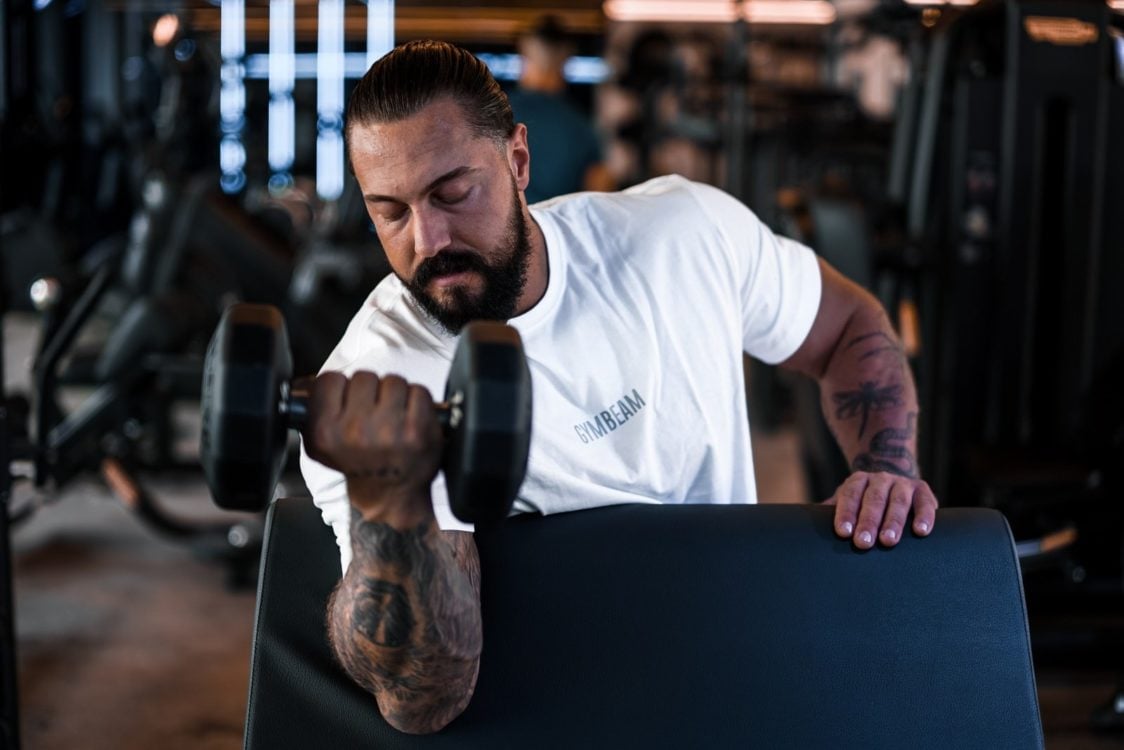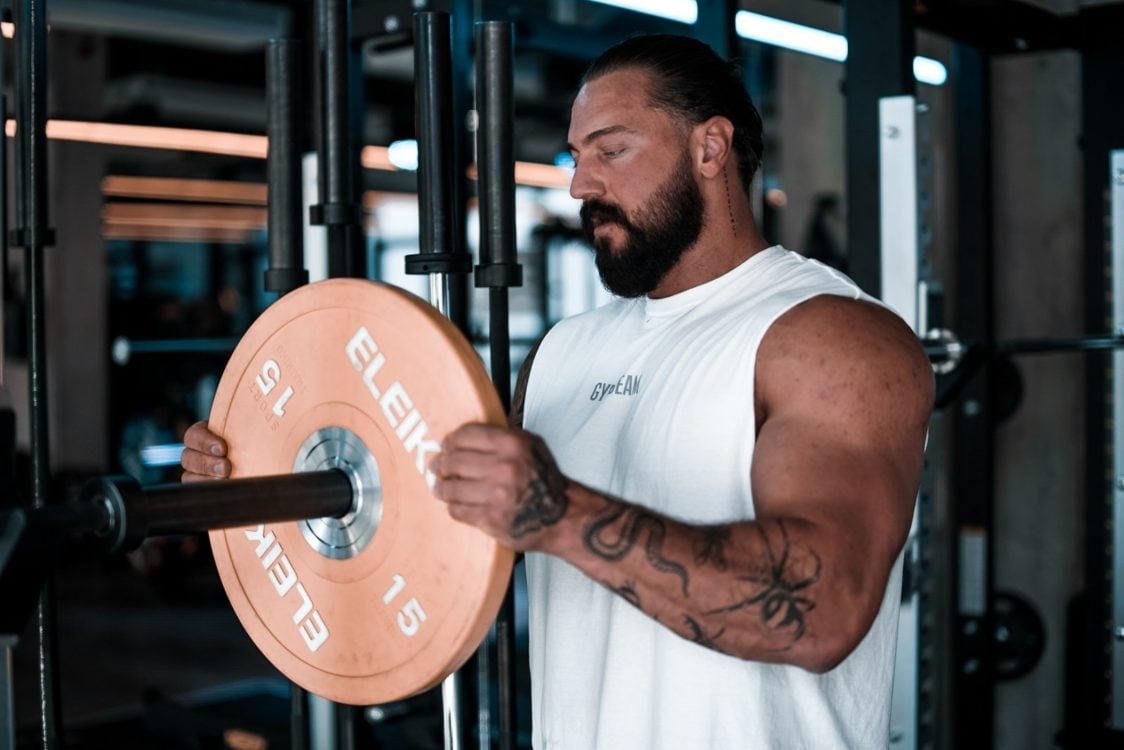Table of Contents
You’ve been working out for a while now, and still no results? Maybe you’re lifting the wrong weight on a barbell or you’ve been training for too long without any change and your body has stopped responding to the load. The right weight is indeed a game changer when it comes to building strength, muscular endurance and muscle growth. In this article you will learn how to set your training load correctly, avoxid stagnation and move closer to your goals.
Why bother with the right training weight at all?
The load you choose to use during training is one of the critical variables in determining the success or failure of your training program. Therefore, first and foremost, it is important to know what do you want to achieve with your training? It is only by answering this seemingly simple question that you can select the appropriate tool in the form of a properly specified load. If it is too small and you train with a low number of repetitions, your muscles will not get enough impetus for growth or strengthening. You will definitely see some results, especially in the beginning. The right weights can take you a lot further in the iron pumping game.
In case you overdo it with the load and train only with the maximum weight, you increase the risk of injury, and place too much strain on the nervous system, not to mention the correct technique. You will overcome a lot of resistance, but by doing only one rep you are unnecessarily depriving yourself of the ideal combination of all training variables for muscle and strength development.
If you want to spend your time in the gym effectively, you need to choose an optimal training plan with the right load that reflects your goals.
Do you have to immediately consider the ideal load when you’re just starting to exercise?
Beginners should focus on learning the correct technique of basic exercises such as the squat or push-up within the first few weeks of training. To start with, your own weight or a lightly loaded barbell is enough. Once the technique is mastered and you are more confident in executing the exercises, you can move on to testing and selecting a suitable weight.

How to establish the appropriate weight?
There are several ways to determine how much to load on the barbell or how heavy to choose a dumbbell. The most common since the golden era of bodybuilding has been to specify 1RM (one-repetition maximum) or 1 repetition with maximum weight. This is the highest weight you can lift for one repetition while maintaining proper technique. You shouldn’t have any strength or energy left for the next repetition. The 1RM is then used to determine the working weight to train with to achieve your training goals. It is given as a percentage of 1RM (for example, 70% of 1RM). [1]
This method is used by most trainers to set up a training plan for their clients and also to check strength gains. Especially for advanced athletes, maximal strength is usually tested before and after the training cycle.
How to determine 1RM?
You can find out how much your maximum lift is by gradually increasing the weight while decreasing the number of reps to one. The second way is to estimate 1RM from the max to a higher number of reps.
1. 1RM maximum test
Based on current knowledge, the following 1RM detection methodology is most commonly recommended:
- warm up your whole body before the 1RM test
- warm up with a weight you can maintain for 5-10 reps
- then take a short rest (1 minute)
- add 5-10% of the weight for the upper body exercises or 10-20% of the weight for the lower body exercises and do 2–3 reps
- followed by 2 minutes rest
- add weight again (% as above) for 2-3 reps
- rest for about 2-4 minutes
- increase the load again, which should bring you closer to attempting 1RM
- if you can handle this weight and still have some in reserve, rest and continue with the next attempt until you are able to lift the weight with a good technique
- 1RM is most often found within 3-5 test sets [2]
In practice, however, the procedure is generally a little simpler:
- first, warm up with a higher number of reps with a light to medium weight
- then increase the load and stick to one repetition
- plan ahead how many sets (max 5) you want to get to 1RM and think about how many kg you will add (the standard is to increase by 5-20%)
- add weight after each successful attempt
- take at least a one minute rest between each attempt

2. Estimate with a higher number of repetitions
This method is more suitable and more importantly safer for beginners who might injure themselves when testing the maximum load for one repetition. This is because they may not yet have mastered the correct technique. If you are one of them, set your max for ten repetitions. Be careful to perform the ten repetitions technically correctly, as the last one should really hurt and burn. Doing an eleventh rep should be beyond you. Next, use the Epley equation, which is commonly used to calculate 1RM.
Epley’s equation:
1RM = weight × (1 + number of repetitions / 30)
Example for a woman who can do 10 reps on a squat with 40kg.
- 1RM = 40 (1+10/30)
- 1RM = 40 (1+0.3)
- 1RM = 40 x 1.3
- 1RM = 53.2 kg
Theoretically, this woman’s maximum (1RM) squat weight would be 53.2 kg.
You can also estimate the 1RM by looking at the percentages in the table below to see what % of the 1RM corresponds to 1–12 repetitions.
Table for estimating % of 1RM by number of repetitions
Number of repetitions | Percentage from 1RM |
|---|---|
| 1 | 100% |
| 2 | 95% |
| 3 | 93% |
| 4 | 90% |
| 5 | 87% |
| 6 | 85% |
| 7 | 83% |
| 8 | 80% |
| 9 | 77% |
| 10 | 75% |
| 11 | 70% |
| 12 | 67% |
What weight should you choose according to your goal?
If you keep training the same way, you can’t expect any shift or new results. In order for the desired changes to take place in your muscles that lead to their growth or strength development, you need to surprise them with a strong enough stimulus. Hence, the principle of progressive overload, which occurs when the training load is higher than the body is used to.
Short-term mechanical and metabolic stress occurs in the muscles along with other physiological reactions. The goal of these processes is to better prepare the body to handle this load a little easier in the future. This will result in an increase in strength and muscle mass. [5]
The best answer to how much to load on your barbell to get the optimal load is after you have determined your goal. Do you see your future in powerlifting and want to focus mainly on strength development? Or are you primarily concerned with muscle growth or muscular endurance?
Whatever goal you choose, remember that besides the load, a well-designed overall training plan, diet and sufficient rest are also very important. Your results are also influenced by your genetic makeup, your body’s hormonal response, and other internal factors that vary a little from person to person.
You might be interested in these products:
1. Target: Greater strength
If your current goal is to do 150 kg for squats and 200 kg for deadlifts, it probably won’t help if you lift no more than 80 kg during your training. In fact, lifting weights that are close to your max is key to increasing your strength. In fact, studies confirm that such loads are where most of the neuromuscular adaptations that lead to strength gains occur. [6-7]
Research has also shown that lifting heavy enough weights is more important for strength training than focusing on the total volume of work. That is, the number of reps and sets you do is not as important as how much weight you lift. But it doesn’t mean you roll up to the gym, lift 90% of your 1RM 3 times, and you’re done. The number of reps and sets still remains a significant variable. [6, 8]
Thus, strength training should be based on heavy weights performed with a small number of repetitions. Loads in the 80-95% 1RM range with 2–6 repetitions trained in 4–6 sets (advanced athletes perform more sets) seem to have the greatest effect. Longer rest periods are then added between sets, usually in the range of ninety seconds to four minutes. This is to allow for the recovery of energy sources in the form of ATP. You see this type of training especially in powerlifters whose domain is multi-joint exercises such as squats, deadlifts or the bench press. [9]

2. Goal: Muscle growth (hypertrophy)
If you’ve been training for a while but feel like you’re not getting anywhere, it might be time to rethink your training plan. Muscle growth isn’t just about getting enough protein. Maybe it’s the inappropriate choice of load. Many people train the same way all the time. They have set a comfortable weight and don’t even realise that their training is not giving them the same results as when they started.
Going to the gym three times a week is not enough to activate muscle growth. It also depends on how and how much you lift. In order to achieve muscle hypertrophy, training adaptations must occur, just as in the case of strength development. According to studies, these occur mainly in the middle load and repetition range. Specifically, loads in the range of 60-80% of 1RM are typically recommended with 8–12 reps trained in 4–6 sets (advanced athletes commonly train more sets). Breaks between sets typically last 1–3 minutes. [6]
Is it necessary to stick to these hypertrophic numbers at all costs?
Ever since the golden days of bodybuilding, every gym-goer will tell you that the best way to go is to do 8–12 reps, otherwise you just won’t grow. However, this is not true. According to a study led by the world’s leading hypertrophy researcher Brad Schoenfeld, even training with lower loads (< 50% of 1RM) in the 6-30 rep range leads to muscle growth. However, this effect has been observed mainly in untrained individuals.
At the same time, it is recommended to have some variability in your training in this respect. It turns out that different rep ranges trigger different signalling pathways leading to hypertrophy. So by alternating the number of reps is beneficial in this regard, which can help you avoid stagnation. You won’t be relying on just one signalling pathway, which may not work as well after a while. The key is to always get yourself close to muscle failure. The last repetition should already be on the edge and the next impossible. This approach has a similar effect to the classical one, according to research. [10-11]
You can read about how to put together a diet and training plan for maximum muscle growth in our article What to Eat and How to Exercise to Finally Gain Muscle?

What is really important when it comes to training for muscle growth?
Unlike increasing strength, the total volume of work (load x number of reps x number of sets) plays a much bigger role here. In fact, its sufficient level is essential for the development of metabolic stress, which is one of the key factors leading to the activation of anabolic processes (processes leading to muscle repair and growth).
This is demonstrated, for example, by a study in which participants were divided into three groups with different loads, number of repetitions and sets. However, the total volume of work was the same. Interestingly, after ten weeks of training, all three groups had comparable results in terms of hypertrophy. However, the small number of reps with higher weight (4 reps with 90% 1RM, 7 sets) had the greatest effect on strength gains.
The authors of the study in their conclusion recommend that people who want to gain muscle and increase strength at the same time should keep their training around 8 reps with 80% 1RM and 4 sets. [12]
You can learn more about how to train with the goal of muscle growth in our article How Many Reps Should You Do to Lose Weight Or Gain Muscle?
3. Goal: Development of muscular endurance
Muscular endurance can be defined as the ability of a muscle to repeatedly overcome or inhibit non-maximal resistance without reducing the efficiency of movement. You use it when swimming or cycling, or on the way home from the shops carrying a heavy bag in each hand. It’s so important in everyday life, and even more so for athletes who need to maintain a constant performance over an extended period of time. This is for example true for runners, cyclists, swimmers, tennis players, football, basketball and other team sports. Conversely, for weightlifters or powerlifters, whose actual performance of lifting a barbell takes only a few seconds, it is of minimal importance. [13]
Developing the muscles’ ability to use oxygen is key to improving muscular endurance. This mainly occurs by increasing the density of blood vessels and the number of mitochondria (cellular power plants) in the muscles. These adaptations occur primarily through exercise with lower weights and higher repetitions. Typically, a load of less than 60% of 1RM and performing fifteen or more repetitions is recommended. [6]
Likewise, you can do push-ups, squats or lunges using just your own weight. Isometric exercises such as the plank or wall sit squat are also effective in building your endurance in certain positions. Shorter rest periods (<1 minute) between sets are sufficient than when building strength and muscle mass. [14]
Recommended load and number of repetitions
Training goal | Load (% of 1RM) | Number of repetitions |
|---|---|---|
| Strength development | 80–95% | 2–6 |
| Muscle mass growth (hypertrophy) | 60–80% | 8–12 |
| Muscular endurance | >15 |
What are the mechanisms behind muscle growth?
A training load induces 3 main processes in the muscles, which stand at the very beginning of muscle growth.
1. Mechanical tension
It is most intense when lifting weights close to our 1RM. There is high tension in the muscles trying to overcome the load applied in the form of a loaded barbell or dumbbell. In addition, it also increases with repetition length, which is referred to as Time Under Tension (TUT). Mechanical tension plays an important role in increasing both strength and muscle growth because mechanosensors respond to it, which then send signals to initiate hypertrophic adaptations. [25]
2. Metabolic stress
It increases with the number of reps in a set and is probably the main reason why muscles grow even after lifting lower weights. Bodybuilders routinely do well over fifteen reps when they come close to muscle failure. The muscles are burning at this point, they are pumped up, and another rep would be unrealistic. It is this muscle exhaustion that creates metabolic stress. This results in the accumulation of lactate, hydrogen ions and other metabolites to which the body responds by triggering anabolic events. [25-26]
3. Muscle damage
Strenuous exercise will damage muscle cells and cause microtrauma. This is what leads to the well-known post-training Delayed Onset Muscle Soreness (DOMS). Muscle damage then needs to be repaired. This sets in motion anabolic processes leading to regeneration, strengthening and enlargement of muscle fibres. [25]
If you want to learn more about the mechanisms causing hypertrophy, read our article Is It True That Strained Muscles Grow Faster?

What weight to choose when losing weight?
You’ve probably heard it said that the best way to lose weight or build muscle is to do a high number of reps with a low load. The idea that you will do dozens of repetitions of biceps lifts and get beautifully muscled and sculpted arms is unfortunately unrealistic and is more of a myth. The basis of successful weight loss remains a caloric deficit, which you can achieve through a diet and a well-set training plan. It should not be lacking in weight training, especially as a tool to maintain muscle mass. [15]
If you want to maintain maximum muscle during weight loss, you need to constantly prove to your body that you still need it. This means giving them enough impetus to maintain and grow. Yes, you read correctly, even in a calorie deficit it is possible to build muscle. This is best achieved by sticking to similar weights and repetitions as you would for hypertrophy (60-80% 1RM, 8-12 reps).
But again, it depends mainly on the total amount of work done. Therefore, even a higher rep count with lower load, which is close to muscle failure, could work. You simply need to exhaust your muscles, and thus induce metabolic stress and other training adaptations leading to muscle growth. As with the recommendations for hypertrophy, it might be worthwhile to load the muscles with varying numbers of reps during weight loss.
If you want to learn more about why strength training is important for weight loss, read our article Diet, Cardio and Strength Training. What Is Best for Weight Loss?

How to modify the load during training?
If you want to vary your workout or are looking for a new boost, you can try the technique of increasing or decreasing the load. More advanced athletes, who need more training variability to push their limits, will find it especially useful. You could try a pyramid or drop set workout, for example.
1. Pyramid technique
In the pyramid technique, you gradually decrease or increase the load.
- Ascending pyramid technique: With each set, you increase the weight while decreasing the number of reps.
- Descending pyramid technique: With each set, you decrease the weight and increase the number of reps. [16]
2. Drop set technique
This method combines both types of the above pyramid techniques.
- Gradually add weight until the point where you can no longer handle the higher weight for the selected number of reps,
- at which point you reduce the load and immediately (without resting) perform another set of reps [17]
This will give the muscle a good workout, which will ultimately promote its growth.
How do you know when to increase the weight on a barbell?
If you’ve been doing 80 kg deadlifts for a few weeks, your muscles have probably already adapted to the load and got stronger. You can tell by the fact that this weight feels lighter than it did a few weeks ago. Your body has already got used to it, so it may be time to increase the load. This is the only way to adhere to the aforementioned principle of progressive overload, which is key to improving performance.
What are the guidelines for increasing the workload?
The process of increasing the load has its own rules. If you add 1 kg to a squat, it probably won’t be enough of a stimulus for the body to respond positively. If, on the other hand, you add 30 kg for the same number of repetitions, you will grind yourself down for a few days and maybe even injure yourself. The best path is the golden mean.
1. Think about the proper technique
Take the correct execution of the exercise as the foundation home with you. Without them, you have nothing to build on. So, before you load more weight plates on your bar, think about whether you’re doing the exercise technique correctly and within your maximum range of motion.
2. Increase the weight gradually
Increase the load by a few % each week. It is generally recommended to add less than 10% to reduce the risk of injury. Also, don’t be afraid to keep the same weight from the previous week if you don’t feel up to the higher load. It may be that you haven’t had a good night’s sleep or simply aren’t feeling your best. In that case, there’s no point in pushing it to the limit at all costs. [18]
3. Try the RPE method
Even the best program from a trainer may not be 100% suitable for you or respect your current state of mind. Each of us is different and we go through different phases. Sometimes we feel more tired and for women, the menstrual cycle plays a part. This is another reason why the Rating of Perceived Exertion (RPE) method is commonly used when increasing the workload and assessing progress. This is a scale from 1 to 10, with 1 being the lowest perceived exertion and 10 being the maximum you can lift for the exercise. If at the end of the set you feel you could still do 2 more reps, this is an 8 RPE. If even 1 more repetition would not be possible, you are at 10 RPE. [19-20]
In your training plan, you can have three sets of six reps with RPE 8. This way you set a weight that you feel you still have two more reps to give after you finish six reps. However, the RPE method is not suitable for beginners. It is especially appreciated by advanced athletes who know their body well. As you increase the load, you can then add reps with a certain RPE each week or drop reps and increase the RPE from eight to nine, for example. [19]
4. You can also add more repetitions or sets
You can also get a new workout boost by adding extra reps or sets. This will increase the overall volume of your workout, which can have a positive effect on muscle growth in particular. Also, supersets are often used, in which, simply put, you combine two exercises. This could be a biceps lift, for example, which you follow up with triceps presses without a break. In this case, you are not increasing the load per se, but by skipping the break, you are increasing the intensity of the workout. As a result, it will be a new stimulus for your body to adapt to. [21]

Periodisation of workouts
Breaking your training plan down into time periods will help you achieve both long and short-term goals. You can take inspiration from professional athletes who typically train on plans broken down into cycles of varying lengths.
These are divided into:
- long-term cycles (macro cycles, typically for several months to a year)
- medium-term cycles (mesocycles, usually for a few weeks)
- short-term cycles (micro cycles, usually for a week)
- training units
In the planning itself, you then progress from long-term macrocycles to the training unit. Respect your goals, the current period and your personality. [22]
Don’t forget to take into account the need for rest in your training plan. It is not necessary to go 100% all the time with the idea that this is the only way you will get results. Feel free to include a deload week once every month or two, during which you reduce the load, the number of reps and even the number of sets. This will give you some rest and the next week you will probably notice that you are doing better strength-wise. [23]
Remember that full muscle recovery after a strength load takes about 24–72 hours. Due to the time required for recovery, it seems advisable to exercise one muscle part approximately twice a week. [24]
For inspiration on how to create a training plan, check out our article How to Prepare a Good Training Plan – Tips, Workouts, Common Mistakes.
What should you remember?
After reading today’s article, you’ll no longer be confused about what weight to load up on in your workout to get results. First, you’ll figure out your 1RM and calculate the ideal weight range and number of reps given your goals. If everything goes as it should, over time you’ll be able to increase your workload weight and move up again in terms of strength or muscle growth. But don’t forget about proper technique and sufficient recovery. If you also support your performance with a balanced diet, success is almost guaranteed.
If you have someone in your inner circle who doesn’t know how to train, don’t forget to share this article with them. These practical tips are sure to help them on their way to fulfilling their goals.
[1] Science for Sport. 1RM Testing. https://www.scienceforsport.com/1rm-testing/
[2] Trénink silových schopností. – https://www.fsps.muni.cz/emuni/data/reader/book-5/07.html
[3] StrengthLog. The Best 1RM Calculator: Calculate Your One Rep Max. – https://www.strengthlog.com/1rm-calculator/
[4] NSCA. Training load chart. – NSCA Training Load Chart
[5] How to Select the Right Intensity and Repetitions for Your Clients. – https://www.acefitness.org/resources/pros/expert-articles/4922/how-to-select-the-right-intensity-and-repetitions-for-your-clients/
[6] Schoenfeld, B. J., Grgic, J., Van Every, D. W., & Plotkin, D. L. Loading Recommendations for Muscle Strength, Hypertrophy, and Local Endurance: A Re-Examination of the Repetition Continuum. – https://doi.org/10.3390/sports9020032
[7] Lawson, D., Vann, C., Schoenfeld, B. J., & Haun, C. Beyond Mechanical Tension: A Review of Resistance Exercise-Induced Lactate Responses & Muscle Hypertrophy. – https://doi.org/10.3390/jfmk7040081
[8] Mattocks, K. T., Buckner, S. L., Jessee, M. B., Dankel, S. J., Mouser, J. G., & Loenneke, J. P. Practicing the Test Produces Strength Equivalent to Higher Volume Training. – https://doi.org/10.1249/MSS.0000000000001300
[9] Stull, K. Built to Order: Strength and Size Considerations. – https://blog.nasm.org/strength-and-size-considerations
[10] Boly, J. Brad Schoenfeld’s 3 Evidence Based Guidelines of Hypertrophy Training. – https://barbend.com/brad-schoenfeld-hypertrophy/
[11] Schoenfeld, B. J., Wilson, J. M., Lowery, R. P., & Krieger, J. W. Muscular adaptations in low- versus high-load resistance training: A meta-analysis. – https://doi.org/10.1080/17461391.2014.989922
[12] The Journal of Strength & Conditioning Research. Effects of 4, 8, and 12 Repetition Maximum Resistance. – https://doi.org/10.1519/JSC.0000000000003575
[13] ScienceDirect Topics. Endurance—An overview.– https://www.sciencedirect.com/topics/medicine-and-dentistry/endurance
[14] AIPT. What is Muscular Endurance and How do you Improve it? – https://www.aipt.edu.au/articles/what-muscular-endurance-and-how-do-you-improve-it
[15] L, C., D, G., J, S., & Jp, F. The Effects of Training Load During Dietary Intervention Upon Fat Loss: A Randomized Crossover Trial. – https://doi.org/10.1080/02701367.2022.2097625
[16] Cattan, G. H. Pyramidal Systems in Resistance Training. – https://doi.org/10.3390/encyclopedia1020035
[17] Lab, A. The Efficacy of Drop Sets in Facilitating Muscle Adaptations by Chinwendu Achonu. – https://www.athleticlab.com/the-efficacy-of-drop-sets-in-facilitating-muscle-adaptations-by-chinwendu-achonu/
[18] South Coast Seminars. ACL Study Day. – https://southcoastseminars.com/blog/2018/10/14/when-progressing-training-not-all-load-is-created-equally
[19] Progressive Rehab & Strength. What is RPE? RPE in Powerlifting. [https://www.progressiverehabandstrength.com/articles/rpe-in-powerlifting-what-is-rpeg
[20] Biolayne. How to Increase Volume Appropriately. – https://biolayne.com/articles/training/how-to-increase-volume-appropriately/
[21] Richter, D. Are Supersets Good for Muscle Growth and Strength? – https://strengthlog.mystagingwebsite.com/supersets-for-muscle-growth-and-strength/
[22] NSCA. BASICS OF STRENGTH AND CONDITIONING MANUAL. – https://www.nsca.com/contentassets/116c55d64e1343d2b264e05aaf158a91/basics_of_strength_and_conditioning_manual.pdf
[23] Muscle & Strength. Deload Weeks: Everything You Need to Know on How to Deload. – https://www.muscleandstrength.com/articles/how-to-deload
[24] Nicholas A. Burd, West, D. W. D., Moore, D. R., Atherton, P. J., Staples, A. W., Prior, T., Tang, J. E., Rennie, M. J., Baker, S. K., & Phillips, S. M. Enhanced amino acid sensitivity of myofibrillar protein synthesis persists for up to 24 h after resistance exercise in young men. – https://doi.org/10.3945/jn.110.135038
[25] Schoenfeld, B. Science and Development of Muscle Hypertrophy.
[26] Schoenfeld, B. The Mechanisms of Muscle Hypertrophy and Their Application to Resistance Training. – https://doi.org/10.1519/JSC.0b013e3181e840f3

